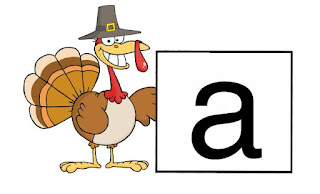The Frenzied SLPs are doing it again...another link up! This time we are showing our gratitude to you, our readers, for sticking with us on this linky journey. So, who wants to have a little fun? Well, if you have been following this link up, than you know already that we are giving away some awesome gift cards to TpT (who doesn't need speech materials?) and Starbucks (more importantly, who doesn't need some coffee?)!
All you have to do is follow a few simple steps to enter to win:
1. Read each Thankful and Grateful post from The Frenzied SLPs!
2. Collect the character at the bottom of each post. Don't forget to write down the characters in order to reveal the secret phrase.
3. Enter the Rafflecopter at the end of any post by entering the phrase.
4. Visit The Frenzied SLPs Facebook Page for an extra entry.
And that's it! Three lucky winners will be chosen after the rafflecopter closes on 11/13/2015. Good luck to you all!!!
So what am I grateful for this Thanksgiving?
Well so much has happened in my family life over the last year but here are the top 5 things I'm thankful for:
1. Retirement!: Um...what? Retirement? Well actually I am very grateful that my husband officially retired from the military after 21 years of service this past February. Of course this means a lot of change, however, the best benefit (hands down) to myself and my children is that for my husband there will be NO MORE DEPLOYMENTS! Yahoo!!! (All the military spouses out there reading this know what a joyous celebration this is. Ha!)
2. Transitions!: Along with retirement came the need to transition from military life to civilian life, which equates to new jobs, a new home, new friends, new...well...everything! So, thanks be to God, my husband was offered a job he enjoys on the east coast, where we were able to relocate to be closer to our extended families as well.
3. Unemployment!: I know you are scratching your head on this one as well but the truth is, when we relocated, I had to close up shop. I had to close the doors to my private practice, which was always my dream, and head due east. Yet the joy I have been given from time with my children has been the most unexpected blessing of it all this year! I will never get that time back and I'm so grateful, I have had it with my two boys.
4. Sleepless Nights!: For over a year now, my youngest, who arrived in late September of 2014, has not slept through the night. He tends to wake up anywhere from 3-5 times a night and this sleep deprived mama was really struggling there for some time. But, I cannot say I didn't love the time I have had snuggling and cuddling with my little guy in the wee hours of the morning! Watching him nurse, or snuggle into me fills me up over and over again and I wouldn't change it for the world! (Picture above just for cuteness!!!)
5. New Horizons!: And lastly, I'm so grateful to have completed the transition to our new home, gotten my newest state speech license, and completed the paperwork to start up my business...again. So, the doors of my private practice are OFFICIALLY open once again!
What a great life I am blessed to live!!!!
So how about you? What are you grateful for this Thanksgiving? I'd love to know!
Ok so if you have started this blog hop, here, you can click on the picture below to take you to the first blog in the hop. If you have been following along on this hop, then by all means, click on the picture for the next blog post. Don't FORGET to grab my letter before you hop right out of here!
Good luck and Happy Thanksgiving!
a Rafflecopter giveaway





































